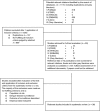Dengue disease surveillance: an updated systematic literature review
- PMID: 24889501
- PMCID: PMC4253126
- DOI: 10.1111/tmi.12333
Dengue disease surveillance: an updated systematic literature review
Abstract
Objectives: To review the evidence for the application of tools for dengue outbreak prediction/detection and trend monitoring in passive and active disease surveillance systems in order to develop recommendations for endemic countries and identify important research needs.
Methods: This systematic literature review followed the protocol of a review from 2008, extending the systematic search from January 2007 to February 2013 on PubMed, EMBASE, CDSR, WHOLIS and Lilacs. Data reporting followed the PRISMA statement. The eligibility criteria comprised (i) population at risk of dengue, (ii) dengue disease surveillance, (iii) outcome of surveillance described and (iv) empirical data evaluated. The analysis classified studies based on the purpose of the surveillance programme. The main limitation of the review was expected publication bias.
Results: A total of 1116 papers were identified of which 36 articles were included in the review. Four cohort-based prospective studies calculated expansion factors demonstrating remarkable levels of underreporting in the surveillance systems. Several studies demonstrated that enhancement methods such as laboratory support, sentinel-based reporting and staff motivation contributed to improvements in dengue reporting. Additional improvements for passive surveillance systems are possible by incorporating simple data forms/entry/electronic-based reporting; defining clear system objectives; performing data analysis at the lowest possible level (e.g. district); seeking regular data feedback. Six studies showed that serotype changes were positively correlated with the number of reported cases or with dengue incidence, with lag times of up to 6 months. Three studies found that data on internet searches and event-based surveillance correlated well with the epidemic curve derived from surveillance data.
Conclusions: Passive surveillance providing the baseline for outbreak alert should be strengthened and appropriate threshold levels for outbreak alerts investigated. Additional enhancement tools such as syndromic surveillance, laboratory support and motivation strategies can be added. Appropriate alert signals need to be identified and integrated into a risk assessment tool. Shifts in dengue serotypes/genotype or electronic event-based surveillance have also considerable potential as indicator in dengue surveillance. Further research on evidence-based response strategies and cost-effectiveness is needed.
Keywords: brote de dengue; dengue; dengue outbreaks; epidemic preparedness; preparación para epidemias; préparation aux épidémies; revisión sistemática; revue systématique; surveillance; systematic review; vigilancia; épidémies de la dengue.
© 2014 The Authors. Tropical Medicine and International Health Published by John Wiley & Sons Ltd.
Figures
References
General References
-
- Bandyopadhyay S, Lum LC. Kroeger A. Classifying dengue: a review of the difficulties in using the WHO case classification for dengue haemorrhagic fever. Tropical Medicine and International Health. 2006;11:1238–1255. - PubMed
-
- Bhatt S, Gething PW, Brady OJ, et al. The global distribution and burden of dengue. Nature. 2013 Doi: 10.1038/nature12060. - DOI - PMC - PubMed
References of included studies (in numerical order as referenced in the text)
-
- Lee K-S, Lai Y-L, Lo S, et al. Dengue virus surveillance for early warning Singapore. Emerging Infectious Diseases. 2010;16 www.cdc.gov/eid. - PMC - PubMed
-
- Lee K-S, Lo S, Tan SS-Y, et al. Dengue virus surveillance in Singapore reveals high viral diversity through multiple introductions and in situ evolution. Infection Genetics and Evolution. 2012;12:77–85. - PubMed
-
- Koh BK, Ng LC, Kita Y, et al. The 2005 dengue epidemic in Singapore: epidemiology, prevention and control. Annals Academy of Medicine Singapore. 2008;37:538–545. - PubMed
Publication types
MeSH terms
Grants and funding
LinkOut - more resources
Full Text Sources
Other Literature Sources
Medical


